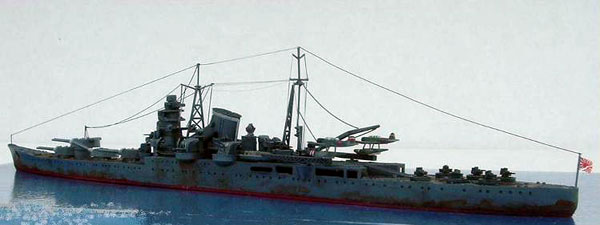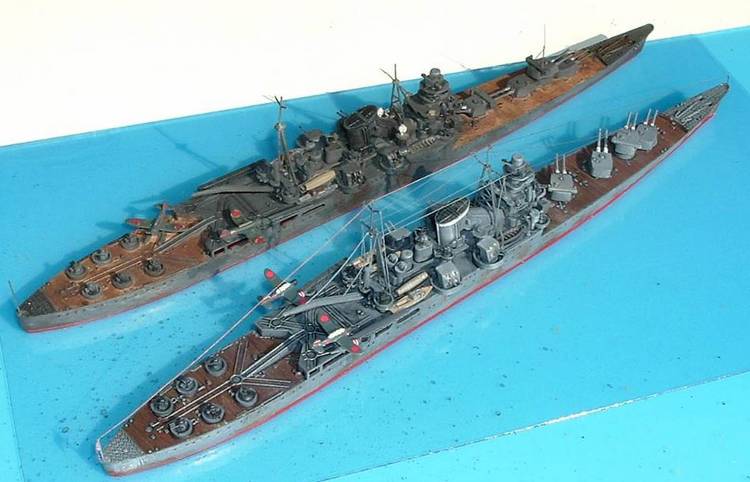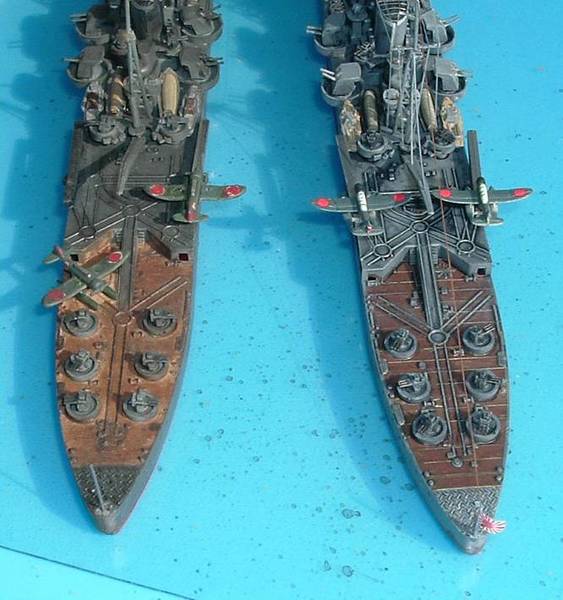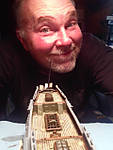You are viewing the archived version of the site.
Go to modelshipwrights.com for the current dynamic site!
Go to modelshipwrights.com for the current dynamic site!
1⁄351/700 IJN Chikuma Heavy Cruiser
10
Comments
Rick's Model

The History of IJN CA Chikuma, Tone Class
Commissioned in May 1939, IJN Chikuma, Tone class CA (heavy cruiser) of 11215-tons, was designed to provided a large seaplane capacity for long-range scouting missions, and was extensively employed with aircraft carriers. One of her planes flew a pre-strike reconnaissance mission over the Pearl Harbor on the infamous December day, and she participated in the capture of Wake Island. After six months of victories, Chikuma suffered the decisive defeat of the Japanese navy at the Battle of Midway on 4 June 1942. Later Chikuma operated with the carriers during the Guadalcanal Campaign, moderately damaged by American SBD attacks during Battle of the Santa Cruz Islands in October.
Sent to Rabaul to counter the 1943 Allied landings on Bougainville, Chikuma was lightly damaged by U.S. carrier planes on November '43. In 1944 she participated in a cruiser raid in the Indian Ocean, then fought in the Battle of the Philippine Sea. Oppossing our invasion of Leyte, Philippines, Chikuma engaged U.S. escort carriers in the Battle off Samar, helping to sink USS Gambier Bay (CVE-73). Subsequentally, after a TBF blew her stern off with a torpedo, she scuttled later on 25 October 1944. The DD that rescued her crew was soon sunk and only one of Chikuma's survivors survived.
The Small rendition of the Chikuma

The AAA guns are pretty good, as is the deck detail, but the rest of the kit features seam lines, sink marks, troublesome fit, and basic detail. The waterline base is a bit too big for the one-piece hull, trimming suggested. The funnel halves are off-register, and the exhaust cap doesn't fit well, either, leaving a gap between the exhaust and funnel. The ship had a white line around the stack, so I covered the gap with a piece of unpainted styrene--two birds, one stone.
But the emperor has new clothes. Fujimi released a version with decals for the brown linoleum that IJN covered its decks with. Brass bands ran between the segments (these are the raised lines running accross the deck), and brass band decals are here, too. The decals worked well. Amazing how well they lined up over the deck details. However, they were to tight, overlapping the barbettes and superstructure. One might want to cut small incisions in the clear areas that overlie metal deck fittings. Originally I used the Micro Scale system. Micro Sol crinkles the decals irrepairably. But Solvaset on decals applied over Micro Set settled great. The deck brass bands are excellent! There are Hinomarus for the five scoutplanes (They also reflect their age) supplied in the kit. Planes from a Skywaves' Heavy Ship detail set replace them, as well as the 20cm main battery, the 9m motor launches and davits for the forward whaleboats. Stretched sprue and fine copper wire rig the vessel, and copper wire makes the mast atop #2 main battery. Model Master acrylic IJN paint was airbrushed on, sealed, and weathered with water-soluble oils for rust and shading.
Overall, it is still a reissued old kit with sinkholes and mold marks, fair detail and some fit problems. Rivet-counting from a tome of IJN Cruisers of the Pacific War shows the AAA compliment is for late-1944 Tone. Chikuma mainly had single AAA guns in lieu of the triple mounts of the kit. I find the decals are novel but think they are not much a work saver over painting--except for the brass bands. Last night I checked Hobby Link Japan and this kit is out of stock.
Online Sources
Chikuma History www.history.navy.mil/photos/sh-fornv/japan/japsh-c/chikuma2.htm
Under attack, Santa Cruz www.history.navy.mil/photos/images/h82000/h82404.jpg
Rabaul raid www.history.navy.mil/photos/images/g80000/g89107.jpg
Hobby Link Japan (online shop) www.hlj.com
Comments
That is an interesting build. That decal idea for the decks certainly sounds like an easier way than doing it with paint.
I have always liked Japanese cruisers. Heck I've always liked cruisers. The Tone/Chikuma class has always been an interesting class to me. I understand the Japanese sailors liked these two ships because they had more room for the crew than the typical cruisers. The Japanes navy wasn't that impressed with them since nearly 12000 tons is a bit high for a cruiser with only 8 big guns. They never did really carry nearly as many scout planes as they were designed for, but very few Japanese ships did.
AUG 16, 2005 - 05:02 AM
Hi Rodger!
Yes you're right (on both points: decals and cruiser looks) I have reordered the pics in a different way, because that sillouette is just smashing!!
Thanks also for sharing your knowledge and spice this story a little bit more
Skipper
AUG 16, 2005 - 05:17 AM
First things first. Rick, for a thirty plus year old kit, I must say, you made her shine. At that scale, the shadowing and highlighting really made the details pop. I'm glad to see that you chose that route, I think that at times some of the ships I've seen were too clean...like antiseptic clean. However, I am of the ilk who believes to each his own. If you like it, that's all that matters.
On to the ship. I'm curious as to the rationale towards the use of linoleum on the decks rather than wood or perhaps steel plate. I would suspect none of three had real non-slip properties, yet I would think that the linoleum would be far more slippery than the other two. (I guess I'm assuming that it did not have a non-skid surface) Also, the forward three turrets. Turret two looks as though it was retro fitted and wedged between one and three. On related note, I wonder why they chose the configuration of six AA tubs on the aft section. Last, but not least, is that tread plate on the bow and stern?
Great little ship Rick. Despite its crazy layout, I really like the lines. Thanks for sharing it.
Steve
AUG 16, 2005 - 05:55 AM
I believe the original plan was for the ships to have six turrets, four forward, two aft. I'm not sure how the plan evolved to change the aft to seaplanes. It fit into Japanese policy of keeping the aircraft carriers planes reserved for strikes, and scout aircraft from cruisers taking care of scouting duties.
This brings up the most famous thing about these ships. It was a scout aircraft from the sister ship Tone that was late getting off at Midway. This was the plane that originally spotted the US fleet.
As to the AA tubs aft I'm not sure but I think they were added when they realized they weren't going to be carrying the full load of aircraft, and needed the extra AA.
BTW, JPTRR, (how do I address you, Rick like Steven did, or John Rick, like skipper did, or Fred like your handle says) I fogot to mention that's a very nicely done model, and a good article on doing it.
AUG 16, 2005 - 08:28 AM
Hi Skipper, Halfyank, and 95Bravo,
Thank you for the interest and kind words.
You can call me Fred, Rick or Fredrick. That's me!
Yes, these are curiously designed ships. Halfyank, thanks for the ship's history. As to why IJN used linoleum, I don't know. I have been supprised that it was on almost all their ships, inc. DDs. I've fielded this question to
SteelNavy
Here are my Chikumas, my first built in the mid to late-70's; a year ago I fixed it up and repainted the Testors Tan deck and unpainted steel. You can now compare the kit turrets, boats and Jake scoutplanes.



AUG 16, 2005 - 09:52 AM
I forgot to add my hypothesis as to the use of linoleum in my last post. Here's what I was thinking...
Perhaps they used linoleum due to the expense and scarcity of wood and or steel. Afterall, Japan was seriously lacking natural resources to begin with. Thus, one of their reasons for exapnsion further into Asia and Pacific. They had no colonies to speak of during the build up years of their Navy, so wood and iron ore would have needed to be imported...thus..more expensive. Where as linoleum is man made...however then you get into the sticky issue of petroleum stockpiles and access...Therefore my hypothesis might be full of holes.
Still think the ships look pretty cool.
And Rodger, thanks for the info on the turrets...it makes sense.
AUG 16, 2005 - 10:26 AM
You may be right but I would think that anything petroleum based would be the last thing they'd use, because they were running so short of oil. Unless this is some special type of linoleum I wouldn't think it would have any qualities over steel or wood, with the exceptiong of maybe being easier to clean up oil stains. I can't believe they'd put linoleum down just for that reason.
The Japanese certainly did odd things with their ships. Who knows how to figure out the inscrutible Japanese mind.
AUG 16, 2005 - 10:49 AM
I have another avenue to explore on this issue. However, we should move this to the History threads....but what a great topic!
I know there's an answer out there and I would suspect that some monkish archivist or historian is sitting on it.
Anyone else have some theories bring them along.
AUG 16, 2005 - 01:11 PM
This stupid mistake (calling John to Fred) is corrected in the article...
I am terribly sorry for mis-calling you, Fred
Skipper
AUG 16, 2005 - 10:37 PM
Hum, yes...the old linoleum and resources question. Linoleum was a sort of product (à la varnish stule if you want) which was added over the steel deck...therefore there was no lack of steel for decks...at least for ships smaller then cruisers. Japan had plenty of colonies already during the 30's...when the Navy comes to it's gold age...you have Taiwan and Korea for starters and then China and Manchuria after that...most of them rich in raw materials. What lacked the most to Japan was in fact OIL which come either from USA, Dutch East Indies, British Borneo and Malaya. I speak this in pre-Pacific War terms. When war broke out anything lacks in long term. Well, but this is an History subject afterall...so feel free to change place. Sorry about the lenght (not as big as usual) but I am an historian afterall
AUG 17, 2005 - 09:35 AM
Copyright ©2021 by Fred Rick Boucher. _OPINIONS Model Shipwrights, KitMaker Network, or Silver Star Enterrpises. Images also by copyright holder unless otherwise noted. Opinions expressed are those of the author(s) and not necessarily those of Model Shipwrights. All rights reserved. Originally published on: 2005-08-16 00:00:00. Unique Reads: 26641























